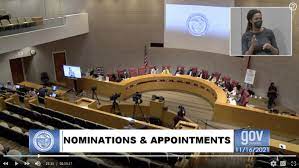In this blog, we’ll explain how to live stream a government meeting and what you need to set it up!
Live streaming is a powerful tool that can benefit the government in many ways. It allows citizens to view government proceedings and decision-making which helps build trust and accountability. Live streaming also makes government affairs more accessible to the public, promoting inclusivity and transparency.
We understand that government meetings can be stressful, and you don’t need the extra stress of wondering whether your live streaming solution will work or not. This is why we’ve created a step-by-step overview of everything to consider when getting started with video live streaming!
How to Live Stream a Government Meeting
1. Find the Right Live Streaming Solution
There are several video streaming solutions, and choosing the right one depends on your specific needs. Especially for government, there are a few more things to consider. Here are some key things to look for in a video streaming solution:
- Reliability: The streaming solution should be reliable, with a high level of uptime and minimal interruptions. It should be able to handle large volumes of traffic, stream for extended periods, and provide a smooth viewing experience for all citizens.
- Security: A streaming solution should have advanced security features such as encryption, user authentication, and access controls to ensure data security. Government should also consider the growing risk of video manipulation and misinformation. Ravnur helps protect government against these threats through video authentication to help verify your original content.
- Customization: Government will often have specific requirements for their video streaming solution. Customizations allow for government branding, user interfaces, or integrations with other systems. The solution should be customizable to meet these needs.
- User experience: The video streaming solution should provide a user-friendly and widely accessible experience for viewers. It should include closed captions, multiple language support, and easy-to-use interfaces.
- Compatibility: As citizens will view live streams from various devices, the video streaming solution should be compatible with a wide range of platforms and devices. It should run smoothly on desktop computers, mobile devices, smart TVs, and more.
- Analytics: It’s important for the video streaming solution to provide analytics and reporting features that allow government to track user engagement, viewing habits, and other metrics to improve the effectiveness of their live streaming efforts.
- Technical support: If you don’t want to spend hours on support calls, you need to look for a video streaming solution with reliable technical support. This will help government troubleshoot issues and avoid potential problems with streaming.
Overall, you should look for a video streaming solution that is reliable, secure, and customizable to your needs. It’s important to find a video partner who understands the unique needs of government and can help you achieve your goals.
2. Determine Technical Requirements
Now that you’ve decided on your live streaming solution, you need to determine the technical requirements to live stream your meetings. This includes the type of equipment needed, internet bandwidth, camera and microphone quality, and the software required to record and stream the meeting. Your technical requirements will greatly depend on your streaming solution. This can range from needing expensive hardware to propping your phone up on a tripod!
Generally speaking, you’ll need a camera that can capture high-quality video. It can be a professional-grade camera or a high-quality webcam, depending on your budget and requirements. You may also need multiple microphones to capture the audio from different speakers in your meetings.
A reliable high-speed internet connection is essential for live streaming. You need to ensure that your connection is stable and fast enough to support live streaming without buffering. It’s also a good idea to have a backup plan in case of any technical issues. This can include having a backup internet connection, an additional camera or microphone, or a backup platform to switch to in case of any issues.
Lastly, you’ll want to ensure your video streaming solution is compatible with your encoder. An encoder is a hardware or software device that converts the video and audio signal into a format that can be broadcasted on the internet. You may need to use an external encoder or use built-in software on your camera or computer.
Live streaming government meetings requires careful planning and preparation to ensure the live stream is secure, reliable, and high-quality. Now that you know how to live stream a government meeting, you need to think about where you’ll share it.
3. Choose Your Streaming Platforms
As well as hosting your live streams on your website, it’s also a good idea to stream to other platforms like YouTube, Facebook, or Twitter. You can research what platforms are most popular in your area and stream on them to increase accessibility and engagement.
It’s a great way to reach more people on platforms they’re already familiar with. Keep in mind, while streaming to these platforms can boost your reach, storing video on third-party platforms can pose several risks:
- Security risks: Third-party platforms may not have the same level of security measures as government-owned systems. Storing sensitive government video data on these platforms could make them vulnerable to cyber attacks, data breaches, and other security risks.
- Ownership and control: Third-party platforms have control over your data and can restrict or delete stored videos. For instance, YouTube will remove government videos that contain copyrighted music or anything deemed as misinformation.
- Compliance: Storing government video on third-party platforms can raise compliance concerns if the platform provider is located in a different country with different data protection regulations.
- Accessibility: Some third-party platforms aren’t up to accessibility standards required by government regulations. Make sure the platforms you use have accessibility features such as an ADA-compliant design, closed captions, and language options.
- Privacy: You might not want all video content to be accessible to the public, especially when streaming events such as school graduations. The government needs to ensure that its platform provider is complying with privacy laws and regulations and that all video data is secure and protected.
It’s important to consider these risks when choosing platforms to stream your government meetings and make sure they fit your needs. Ravnur makes this process much simpler by securely storing all content on your cloud while simultaneously streaming to multiple platforms to increase your reach!
4. Use a Secure Video Archive
Once you’ve decided on your streaming solution, hardware, and platforms, you still need to consider where and how you’ll store your video.
You’ll generally have two options to do this:
- Use on-premise hardware to own and control your data, but run the risk of it being lost or damaged.
- Move your video to the cloud, where your data is secure, backed up, and easily available.
If you decide to store your video on the cloud, it’ll be much easier to scale as you don’t have to buy more expensive hardware to expand your storage. With cloud video storing, you only pay for what you need and use.
Another benefit of storing video on the cloud is that it’s always safe and secure. Since government must keep a public record of meetings, you don’t want to risk losing all your data with on-premise video storage. It’s also easy for anyone in your team to use video in the cloud, and you no longer need specialized personnel to access and maintain your data.
Tips for a Successful Live Stream
Now that you know how to live stream a government meeting, it’s time to go live!
Here are some final tips to improve your live streams and increase engagement:
Always test your equipment beforehand! Double-check that your audio and video equipment is functioning properly, and the live streaming platform is up. Also, be sure to have a backup plan in case of technical difficulties, such as a secondary camera or microphone.
It’s good practice to make sure the area is well-lit and visual aids such as slides or graphics can help make key points more engaging to viewers. After your live stream, you can also share the archived video by promoting it through social media, email marketing, and other communication channels to increase its views.
If you’re looking for help with live streaming your meetings, reach out to our team at Ravnur! We can support you through every step of the process. As government’s most trusted video partner, we understand your needs and can help ensure your videos are accessible, compliant, and autheticated.
As Ravnur runs in the Microsoft Azure cloud, we have a fast-track deployment option for Azure customers to get you running in minutes! Read more about it here.


